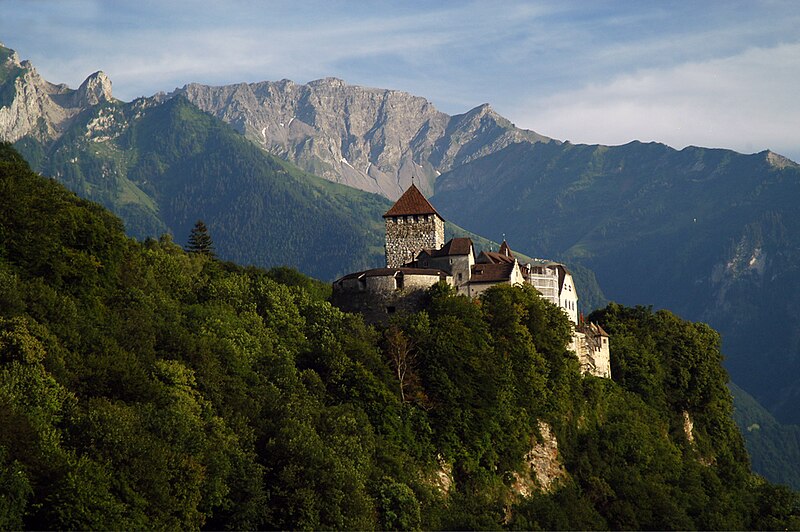by Susan Flantzer
© Unofficial Royalty 2019

Credit – Wikipedia
Prince Hans-Adam II of Liechtenstein was born on February 14, 1945, in Zurich, Switzerland. He was the eldest of the five children of Prince Franz Josef II of Liechtenstein and Countess Georgina von Wilczek. His father succeeded as Prince of Liechtenstein upon the death of his childless great-uncle Prince Franz I of Liechtenstein in 1938. Hans-Adam’s paternal grandparents were Prince Aloys of Liechtenstein and Archduchess Elisabeth Amalie of Austria. Archduchess Elisabeth Amalie’s father Archduke Karl Ludwig of Austria was the younger brother of Emperor Franz Joseph I of Austria, the father of Archduke Franz Ferdinand of Austria, whose assassination ignited World War I, and the grandfather of Karl I, the last Emperor of Austria. Hans-Adam’s maternal grandparents were Ferdinand, Count of Wilczek and Countess Norbertine Kinsky of Wchinitz und Tettau. Hans-Adam married Countess Marie Aglaë of Wchinitz and Tettau and had three sons and one daughter.
Prince Hans-Adam has 23 paternal first cousins and no maternal first cousins because his mother was an only child. He shares his first cousins with his siblings Prince Phillipp Erasmus of Liechtenstein, Prince Nikolaus of Liechtenstein, Princess Nora of Liechtenstein, and Prince Wenzel of Liechtenstein.
******************
Prince Hans-Adam’s Paternal Aunts and Uncles: Children of Prince Aloys of Liechtenstein and Archduchess Elisabeth Amalie of Austria
- Princess Maria Theresia of Liechtenstein, Countess von Gross-Zauche und Camminetz (1908 – 1973), married Count Arthur Strachwitz von Gross-Zauche und Camminetz, had issue
- Prince Karl Alfred of Liechtenstein (1910 – 1985), married Archduchess Agnes Christina of Austria, had issue
- Prince Georg Hartmann of Liechtenstein (1911 – 1998), married Duchess Marie Christine of Württemberg, had issue
- Prince Ulrich Dietmar of Liechtenstein (1913 – 1978), unmarried
- Princess Marie Henriette of Liechtenstein, Countess von Eltz genannt Faust von Stromberg (1914 – 2011), married Count Peter von Eltz genannt Faust von Stromberg, had issue
- Prince Aloys Heinrich of Liechtenstein (1917 – 1967), unmarried
- Prince Heinrich Hartneidof Liechtenstein (1920 – 1993), married Countess Amalie von Podstatzky-Lichtenstein, had issue
******************
PATERNAL FIRST COUSINS
Paternal First Cousins: Children of Princess Maria Theresia of Liechtenstein and Artur Graf Strachwitz von Gross-Zauche and Camminetz
- Antonius Graf Strachwitz of Gross-Zauche and Camminetz (born 1944), unmarried
- Stanislaus Graf Strachwitz of Gross-Zauche and Camminetz (born 1946), married Eva Kattner, had three daughters
- Stephanie Grafin Strachwitz of Gross-Zauche and Camminetz (born 1948), married Guido Nikolaus Schmidt-Chiari, had three sons and three daughters
******************
Paternal First Cousins: Children of Prince Karl Alfred of Liechtenstein and Archduchess Agnes Christina of Austria
- Prince Dominik of Liechtenstein (1950 – 2009), married Eva Maria Lösch, no children
- Prince Andreas of Liechtenstein (born 1952), married Silvia Prieto y Figueroa, no children
- Prince Gregor of Liechtenstein (born 1954), unmarried
- Princess Alexandra of Liechtenstein (1955 – 1993), married Hans Lovrek, and divorced, no children

Credit – Wikipedia
Princess Maria Pia of Liechtenstein (born 1960)
Princess Maria Pia of Liechtenstein married Max Alexander Kothbauer and had one son. She is a diplomat and has served as Ambassador of Liechtenstein to Belgium, to the European Union, to Austria, and to the Czech Republic.
Wikipedia: Princess Maria Pia of Liechtenstein
- Princess Katharina of Liechtenstein (born 1964), (1) married and divorced Jeremy Kelton, had one son (2) Andrew Gammon, no children
- Princess Birgitta of Liechtenstein (born 1967), married Otto Count Jankovich-Bésán de Pribér, Vuchin et Duna-Szekcsö, had one son and one daughter
******************
Paternal First Cousins: Children of Prince Georg Hartmann of Liechtenstein and Marie Christine, Duchess of Württemberg
- Princess Margarita of Liechtenstein (1950 – 2013), married Hans Peter Klien, had one son and one daughter
- Princess Maria Assunta (born 1952), married Harald Link, had one daughter and one son
- Princess Isabelle Maria of Liechtenstein (born 1954), married Raimund, Count zu Erbach, had three sons and one daughter
- Prince Christoph (born 1958), unmarried
- Princess Marie Helene of Liechtenstein (born 1960), unmarried
- Princess Georgina of Liechtenstein (born 1962), married Clemens, Count of Waldburg zu Zeil and Trauchburg, had three daughters and two sons
- Princess Michaela of Liechtenstein (born 1969), married Alexander Heuken, had one son
******************
Paternal First Cousins: Children of Princess Henriette of Liechtenstein and Peter Graf von Eltz genannt Faust von Stromberg
- Johannes Graf von Eltz genannt Faust von Stromberg (born 1946), married Felizitas Urbanski von Ostrymiecz, had one son
- Alexander Graf von Eltz genannt Faust von Stromberg (born 1947), married Maya Monika Spann, had two daughters and one son
- Franz Josef Graf von Eltz genannt Faust von Stromberg (born 1950), married Katharina Elisabeth O’Donoghue, had one son and one daughter
******************
Paternal First Cousins: Children of Prince Heinrich Hartneid of Liechtenstein and Amalie Countess von Podstatzky-Lichtenstein
- Princess Maria Elisabeth of Liechtenstein (1969), married Gilles Rouvinez, no children
- Prince Hubertus Aloys of Liechtenstein (born 1971), married Claudia Rüegg, no children
- Princess Marie Therese Eleonore (born 1974)
******************
No Maternal First Cousins
******************
This article is the intellectual property of Unofficial Royalty and is NOT TO BE COPIED, EDITED, OR POSTED IN ANY FORM ON ANOTHER WEBSITE under any circumstances. It is permissible to use a link that directs to Unofficial Royalty
Works Cited
- Lundy, D. (2019). Main Page. [online] Thepeerage.com. Available at: http://www.thepeerage.com/. (for genealogy information)
- Unofficial Royalty. (2019). Unofficial Royalty. [online] Available at: https://www.unofficialroyalty.com. (for biographical and genealogy information)
- Wikipedia. (2019). Main Page. [online] Available at: https://en.wikipedia.org/. (for biographical and genealogy information)
























